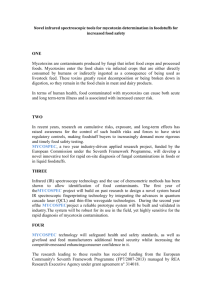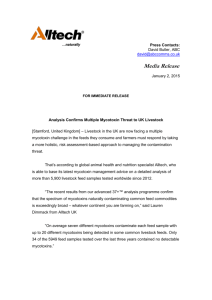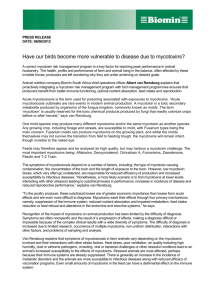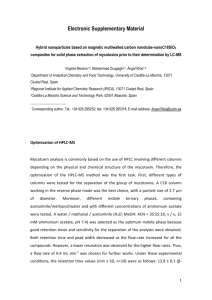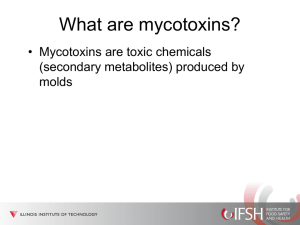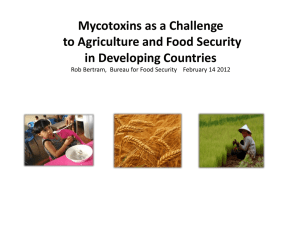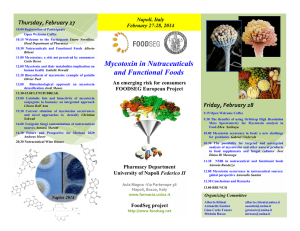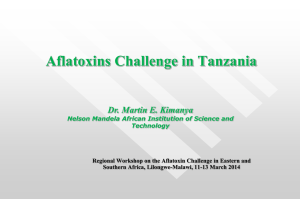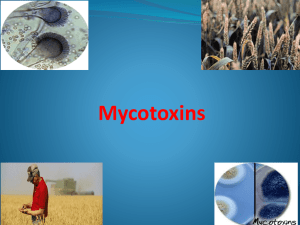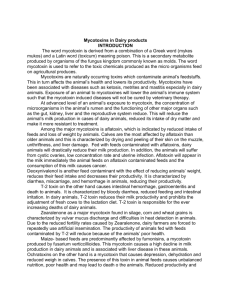IDF-Factsheet-Feed-associated-mycotoxins
advertisement
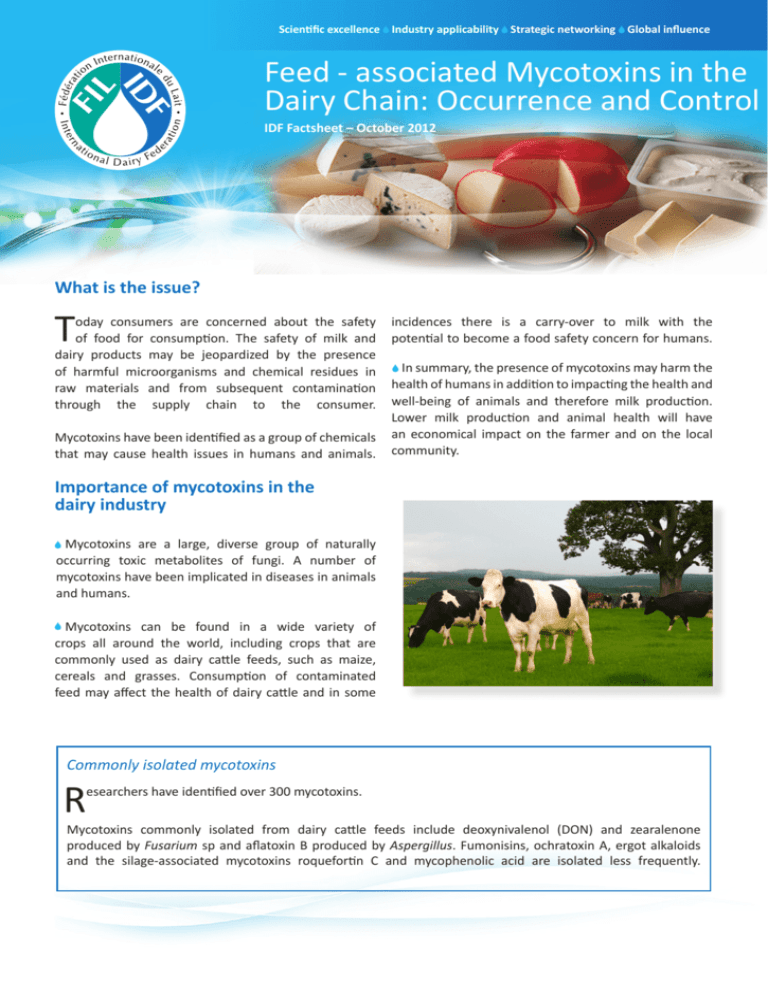
Scientific excellence Industry applicability Strategic networking Global influence Feed - associated Mycotoxins in the Dairy Chain: Occurrence and Control IDF Factsheet – October 2012 What is the issue? T incidences there is a carry-over to milk with the potential to become a food safety concern for humans. Mycotoxins have been identified as a group of chemicals that may cause health issues in humans and animals. In summary, the presence of mycotoxins may harm the health of humans in addition to impacting the health and well-being of animals and therefore milk production. Lower milk production and animal health will have an economical impact on the farmer and on the local community. oday consumers are concerned about the safety of food for consumption. The safety of milk and dairy products may be jeopardized by the presence of harmful microorganisms and chemical residues in raw materials and from subsequent contamination through the supply chain to the consumer. Importance of mycotoxins in the dairy industry Mycotoxins are a large, diverse group of naturally occurring toxic metabolites of fungi. A number of mycotoxins have been implicated in diseases in animals and humans. Mycotoxins can be found in a wide variety of crops all around the world, including crops that are commonly used as dairy cattle feeds, such as maize, cereals and grasses. Consumption of contaminated feed may affect the health of dairy cattle and in some Commonly isolated mycotoxins R esearchers have identified over 300 mycotoxins. Mycotoxins commonly isolated from dairy cattle feeds include deoxynivalenol (DON) and zearalenone produced by Fusarium sp and aflatoxin B produced by Aspergillus. Fumonisins, ochratoxin A, ergot alkaloids and the silage-associated mycotoxins roquefortin C and mycophenolic acid are isolated less frequently. Scientific excellence Industry applicability Strategic networking Global influence IDF Factsheet – October 2012 Factors influencing mycotoxin production Impact of mycotoxins on animals I T mportant factors influencing mould growth are moisture (water activity (aw)), temperature and availability of nutrients and oxygen. The ability of a mould species to produce mycotoxins is genetically determined however the production of mycotoxins occurs only over limited ranges of aw and temperature. Other factors, such as availability of nutrients and the levels of oxygen and carbon dioxide, play a role in the mycotoxin production. Mechanical damage or insect attack of plants or grain kernels causes disruption of the protective plant cell wall thus creating entry points for infective moulds. In addition, the damage causes release of nutrients from the plant endosperm that can be used by moulds for growth. he rumen has an important function in the metabolism of mycotoxins in cattle. DON and ochratoxin A are transformed into less toxic metabolites in the rumen. For that reason cattle are less sensitive to these mycotoxins than non-ruminant animals such as pigs. Zearalenone is transformed in the rumen into different metabolites, with varying toxic activities. Aflatoxin B1 and fumonisins are not metabolized in the rumen. Aflatoxin B1 is transformed in the liver into aflatoxin M1 Mycotoxins can cause a wide variety of toxic effects in cattle. The major symptoms of mycotoxin intoxication in dairy cattle are: • • • reduced feed intake and milk production, reduced reproductive efficiency and immunosuppression. Little is known about the effects of frequent exposure of animals to low doses of mycotoxins on chronic health problems and about possible synergistic or antagonistic effects. Mycotoxins in milk T Contamination of crops and feed ingredients is affected by geographic origin, weather conditions during crop growth, and conditions during processing and storage. Contamination by DON and zearalenone usually occurs in crops produced in temperate climate regions, whereas contamination by aflatoxin B1 usually occurs in subtropical and warm temperate climates. Feedstuffs based on maize have a high risk of being contaminated by one or more mycotoxins. ransmission of mycotoxins or metabolites from feed to milk (carry-over) is of key importance with regard to food safety aspects of milk and milk products and compliance with legal standards. Excretion in milk by lactating animals can occur only when the mycotoxin or its metabolite(s) is able to pass the blood-milk barrier. Aflatoxin B1 is the only mycotoxin with significant carry-over into milk (as aflatoxin M1). Aflatoxin M1 is the only mycotoxin of concern to food safety of milk and dairy products. The other mycotoxins associated with dairy cattle feed are not of practical relevance due to their low feed-to-milk carry-over rates. IDF Factsheet – October 2012 The main concern of aflatoxin M1 in relation to human health is its carcinogenicity. Like aflatoxin B1, aflatoxin M1 is presumed to induce liver cancer. However, the carcinogenic potency of aflatoxin M1 is assumed to be about ten times less than that of aflatoxin B1. Management of mycotoxins by the dairy industry Control and prevention of mycotoxins in animal feed and milk A lthough the understanding of the ecology of mycotoxigenic moulds and mycotoxin formation in feed crops and stored feeds has grown significantly in the last twenty years, complete elimination of mycotoxins from the dairy production chain is not possible. National and international organizations have developed HACCP (Hazard Analysis and Critical Control Point technique) based programs for mycotoxin control and prevention including codes of practice for crop growth, harvest, storage, processing and distribution of feed products. Strategies for decontamination and detoxification have been developed. Table 1 summarizes recommended control measures across the animal feed supply chain. may have on animal productivity and protecting human health when animal products are consumed. Thirty nine countries have regulations for aflatoxin B1 in feed with the most common limit concentration of 5 µg/kg. Currently no regulations for other mycotoxins in feed are in place. Sampling and analytical techniques V alidated sampling and analytical procedures for the detection of mycotoxins in feeds and dairy products and effective laboratory quality assurance programs are essential tools in mycotoxin monitoring programs. Validated sampling techniques are very important given the normally heterogeneous distribution of mycotoxins in feeds and ingredient materials. International Standards Organisation (ISO) and other national bodies have published standards for sampling of animal feeds. Regulation Over sixty countries have regulations for aflatoxin M1 in milk. The common prevailing limit concentrations for aflatoxin M1 in milk are 0.05 µg/kg and 0.5 µg/kg. Based on a quantitative risk assessment the Codex Alimentarius established a limit concentration for aflatoxin M1 in milk at 0.5 µg/kg. Establishment of regulations for aflatoxins in animal feedstuffs is directed at protecting the health of the animal and thus limiting the economic damage due to the adverse effects that aflatoxins Commonly used analytical methods include physiochemical techniques and immunoassays. Commercial ELISA based techniques are frequently used for rapid screening of raw materials used for feed and milk. National and international groups that have published standard methodology have validated many of these techniques. IDF Factsheet – October 2012 Table 1 Recommended practices for the prevention and reduction of aflatoxin B1 in raw materials and feedstuffs for milk producing animals and trichothecenes, zearalenone, fumonisins and ochratoxin A in cereals (from Codex Alimentarius codes of practice) Preharvest Apply crop rotation, to reduce infection pressure; Remove crop residues from field, for instance by deep ploughing, to reduce infection pressure; Use seed varieties developed for resistance to fungal infections; Apply fertilization in conformity to crop demand, to avoid plant stress; Apply good agronomic practices (irrigation, weed control, plant spacing) and avoid plant stress from high temperatures and drought; Apply proper phytosanitary measures on seeds and crops, to avoid insect damage and fungal infections; Minimize mechanical damage, to avoid plant stress and fungal infections. Harvest Plan to harvest at full maturity, unless extreme plant stress conditions are anticipated. Avoid delayed harvesting, to reduce risk of mycotoxin accumulation; Avoid mechanical damage of grain kernels, to avoid fungal infections during storage; Where applicable dry to moisture level required to prevent mould growth during storage as quickly as possible; Remove foreign matter and visibly infected material where applicable. Storage Use clean, dry and well-vented storage facilities that are protected from entry of rain, rodents and birds; Store at as low a temperature as low as possible. Where possible aerate by circulation of air to maintain uniform temperature and moisture; Minimize the levels of insects and moulds in the storage facility by appropriate approved methods; Where applicable use appropriate approved preservatives to prevent mould growth. Transport Ensure that transport containers are dry and free of insects, moulds and contaminated material; Protect shipments from moisture entry and avoid temperature fluctuations that may cause condensation. International Dairy Federation www.fil-idf.org Bulletin of International Dairy Federation 444/2010 Feed Associated Mycotoxins in the Dairy Chain: Occurrence and Control Codex Alimentarius http://www.codexalimentarius.net/web/index_en.jsp European Mycotoxins Awareness Network (EMAN) www.mycotoxins.org FAO Food Safety and Quality Service (AGNS) Mycotoxins http://www.fao.org/ag/agn/agns/chemicals_mycotoxins_en.asp Mycotoxins on the Farm http://www.knowmycotoxins.com/index.htm SELAMAT a network for international co-operation on food safety issues between Europe and Asia http://www. selamat.net/default.aspx USA Food and Drug Administration Food Safety http://www.fda.gov/Food/FoodSafety/FoodContaminantsAdulteration/NaturalToxins/default.htm
